 W
WRichard III was King of England and Lord of Ireland from 1483 until his death in 1485. He was the last king of the House of York and the last of the Plantagenet dynasty. His defeat and death at the Battle of Bosworth Field, the last decisive battle of the Wars of the Roses, marked the end of the Middle Ages in England. He is the protagonist of Richard III, one of William Shakespeare's history plays.
 W
WAnne Neville was an English queen, the younger of the two daughters and co-heiresses of Richard Neville, 16th Earl of Warwick. She became Princess of Wales as the wife of Edward of Westminster and then Queen of England as the wife of King Richard III.
 W
WIn July 1482 an English army invaded Scotland during the Anglo-Scottish Wars. The town of Berwick-upon-Tweed and its castle were captured and the English army briefly occupied Edinburgh. These events followed the signing of the Treaty of Fotheringhay, 11 June 1482, in which Alexander Stewart, Duke of Albany, the brother of James III of Scotland declared himself King of Scotland and swore loyalty to Edward IV of England. The follow-up invasion of Scotland under the command of Edward's brother, Richard, Duke of Gloucester failed to install Albany on the throne, but Berwick has remained English ever since the castle surrendered on 24 August. The English army left Edinburgh with a promise for the repayment of the dowry paid for the marriage of Princess Cecily of England to the Scottish Prince.
 W
WThe Black Adder is the first series of the BBC sitcom Blackadder, written by Richard Curtis and Rowan Atkinson, directed by Martin Shardlow and produced by John Lloyd. The series was originally aired on BBC 1 from 15 June 1983 to 20 July 1983, and was a joint production with the Australian Seven Network. Set in 1485 at the end of the British Middle Ages, the series is written as a secret history which contends that King Richard III won the Battle of Bosworth Field, only to be unintentionally assassinated by his nephew's son Edmund and succeeded by said nephew, Richard IV, one of the Princes in the Tower. The series follows the exploits of Richard IV's unfavoured second son Edmund in his various attempts to increase his standing with his father and, in the final episode, his quest to overthrow him.
 W
WAnnette Josephine Carson is a British non-fiction author specialising in history, biography and aviation, with a particular interest in King Richard III. Since 2002 she has also been an advocate for UK state pension parity for UK expatriates.
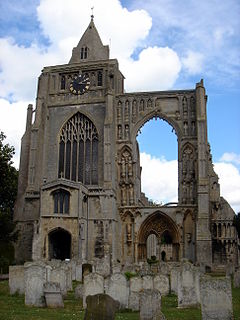 W
WThe Croyland or Crowland Chronicle is an important primary source for English medieval history, particularly the late 15th century. It is named for its place of origin, the Benedictine Abbey of Croyland or Crowland, in Lincolnshire, England. It was formerly also known as the Chronicle of Ingulf or Ingulphus after its supposed original compiler, the 11th-century abbot Ingulf. As that section of the text is now known to have been a later forgery, its author is instead known as Pseudo-Ingulf. The validity of the source itself has been questioned, partially due to the unknown identity of the original author, and gaps in all continuations of the text. There has also been substantially little effort made to find and translate the original manuscript.
 W
WThe Daughter of Time is a 1951 detective novel by Josephine Tey, concerning a modern police officer's investigation into the alleged crimes of King Richard III of England. It was the last book Tey published in her lifetime, shortly before her death. In 1990 it was voted number one in The Top 100 Crime Novels of All Time list compiled by the British Crime Writers' Association. In 1995 it was voted number four in The Top 100 Mystery Novels of All Time list compiled by the Mystery Writers of America.
 W
WThe exhumation and reburial of Richard III of England began with the discovery of the king's remains within the site of the former Greyfriars Friary Church in Leicester, England, in September 2012. Following extensive anthropological and genetic testing, the remains of Richard III, the last English king killed in battle, were ultimately reinterred at Leicester Cathedral on 26 March 2015.
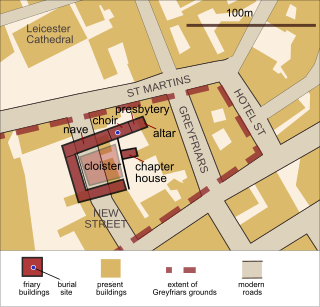 W
WGreyfriars, Leicester, was a friary of the Order of Friars Minor, commonly known as the Franciscans, established on the west side of Leicester by 1250, and dissolved in 1538. Following dissolution the friary was demolished and the site levelled, subdivided, and developed over the following centuries. The locality has retained the name Greyfriars particularly in the streets named "Grey Friars", and the older "Friar Lane".
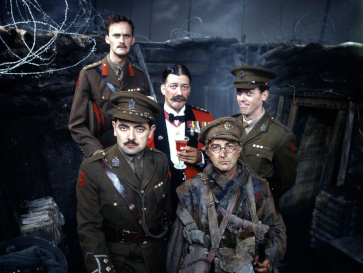 W
WThis article lists the characters in the four series and three special episodes of the British sitcom Blackadder. Blackadder was notable for featuring actors playing many repeating characters across different eras of history, with Rowan Atkinson as the central character Edmund Blackadder, and Tony Robinson as his sidekick Baldrick, together with numerous other actors in one-off parts.
 W
WKing Richard III Visitor Centre is an establishment in Leicester, England, that showcases the life of King Richard III and the story of how his remains were discovered in 2012. The centre opened in 2014 on the site of Greyfriars, the medieval friary where the King was originally buried.
 W
WMiddleham Castle is a ruined castle in Middleham in Wensleydale, in the county of North Yorkshire, England. It was built by Robert Fitzrandolph, 3rd Lord of Middleham and Spennithorne, commencing in 1190. The castle was the childhood home of King Richard III, although he spent very little of his reign there. The castle was built to defend the road from Richmond to Skipton, though some have suggested the original site of the castle was far better to achieve this than the later location. After the death of King Richard III the castle remained in royal hands until it was allowed to go to ruin in the 17th century. Many of the stones from the castle were used in other buildings in the village of Middleham.
 W
WThe Plantagenet Alliance was a small grouping of individuals claiming to be descendants of the House of Plantagenet. The Alliance was formed in 2013 shortly after the discovery and identification of the remains of Richard III, the last Plantagenet king of England who died in 1485, in order to advance their views on the location of Richard's reburial. Reports of the number of members of the Alliance vary between fifteen and around forty.
 W
WRichard Plantagenet or Richard of Eastwell was a reclusive bricklayer who was claimed to be a son of Richard III, the last Plantagenet King of England.
 W
WThe Princes in the Tower is an expression frequently used to refer to Edward V, King of England and Richard of Shrewsbury, Duke of York. The two brothers were the only sons of Edward IV, King of England and Elizabeth Woodville surviving at the time of their father's death in 1483. When they were 12 and 9 years old, respectively, they were lodged in the Tower of London by the man appointed to look after them, their uncle, the Lord Protector: Richard, Duke of Gloucester. This was supposedly in preparation for Edward's forthcoming coronation as king. However, before the young king could be crowned, he and his brother were declared illegitimate. Their uncle, Richard, ascended to the throne.
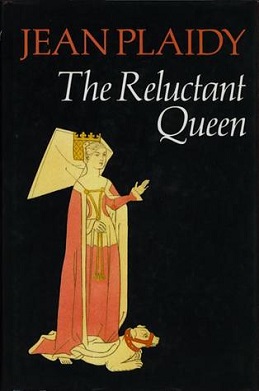 W
WThe Reluctant Queen is a novel by historical novelist Jean Plaidy which tells the tale of Anne Neville, the wife of King Richard III of England. It weaves the tale of Anne's life told in first person. The book was published in the US as The Reluctant Queen: The Story of Anne of York
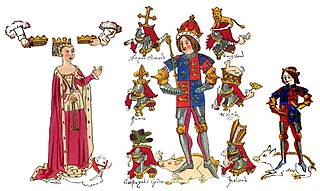 W
WRicardians are people interested in altering the posthumous reputation of King Richard III of England. Richard III has long been portrayed unfavourably, most notably in William Shakespeare's play Richard III, in which Richard is portrayed as having murdered his 12-year-old nephew Edward V in order to secure the English throne for himself. Ricardians have worked in an effort to turn this around and to paint this portrayal, and the many other related assertions that followed, as most probably false politically-motivated accusations.
 W
WRichard III of England has been depicted in literature and popular culture many times. In the Tudor period he was invariably portrayed as a villain, most famously in Shakespeare's play Richard III, but also in other literature of the period. Richard's life was not much depicted again until the 20th century when the "Ricardian" movement sought to restore his reputation. Much of more recent creative literature has portrayed him in a positive light. However his reputation as a hunchbacked villain has remained a familiar historical cliché within popular culture.
 W
WRichard III is a play by William Shakespeare. It was probably written around 1593. It is labelled a history in the First Folio, and is usually considered one, but it is sometimes called a tragedy, as in the quarto edition. Richard III concludes Shakespeare's first tetralogy and depicts the Machiavellian rise to power and subsequent short reign of King Richard III of England.
 W
WThe Richard III Experience at Monk Bar is located in Monk Bar, the tallest of the four gatehouses in the historical city walls of York, England. It describes the life of Richard III, the last king of the Plantagenet dynasty.
 W
WThe Sunne in Splendour is a historical novel written by Sharon Kay Penman. Penman became interested in the subject of Richard III while a student and wrote a manuscript that was stolen from her car. She rewrote the manuscript which was published in 1982.
 W
WTitulus Regius is a statute of the Parliament of England, issued in 1484, by which the title of King of England was given to Richard III.
 W
WThe True Tragedy of Richard III is an anonymous Elizabethan history play on the subject of Richard III of England. It has attracted the attention of scholars of English Renaissance drama principally for the question of its relationship with William Shakespeare’s Richard III.
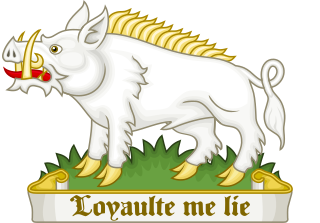 W
WThe White Boar was the personal device or badge of the English King Richard III of England, and is an early instance of the use of boars in heraldry.